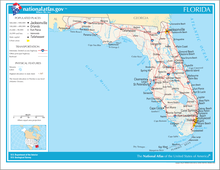Outline of Florida
Appearance

The following outline is provided as an overview of and topical guide to the U.S. state of Florida:
Florida – third most populous and the southeasternmost of the 50 states of the United States of America. Florida lies between the Gulf of Mexico and the North Atlantic Ocean. The Territory of Florida joined the Union as the 27th state on March 3, 1845. Florida joined the Confederate States of America during the American Civil War from 1861 to 1865, but was readmitted to the Union in 1868.
General reference

- Names
- Common name: Florida
- Pronunciation: /ˈflɒrɪdə/
- Official name: State of Florida
- Abbreviations and name codes
- Nicknames
- Common name: Florida
- Adjectival: Florida
- Demonym: Floridian
Geography of Florida
- Florida is: a U.S. state, a federal state of the United States of America
- Location
- Population of Florida: 18,801,310 (2010 U.S. Census[3])
- Area of Florida
- Atlas of Florida
Places in Florida
- Historic places in Florida
- National Natural Landmarks in Florida
- National parks in Florida
- State parks in Florida
Environment of Florida
- Climate of Florida
- Geology of Florida
- Protected areas in Florida
- Superfund sites in Florida
- Wildlife of Florida
- Fauna of Florida
Natural geographic features of Florida
Regions of Florida
Administrative divisions of Florida

Demography of Florida
Government and politics of Florida
- Form of government: U.S. state government
- United States congressional delegations from Florida
- Florida State Capitol
- Elections in Florida
- Political party strength in Florida
- Florida and the Declaration of Independence
Branches of the government of Florida
Executive branch of the government of Florida
- Governor of Florida
- State departments
Legislative branch of the government of Florida
Judicial branch of the government of Florida
Law and order in Florida
- Capital punishment in Florida
- Constitution of Florida
- Crime in Florida
- Gun laws in Florida
- Law enforcement in Florida
- Same-sex marriage in Florida
Military in Florida
History of Florida
History of Florida, by period



- Prehistory of Florida
- Maritime history of Florida since 1513
- On Easter Sunday, April 2, 1513, a Spanish expedition led by Juan Ponce de León lands on a huge inhabited island (later determined to be a continental peninsula) that he names La Pascua Florida (the Feast of Flowers, now Florida).
- Spanish colony of Ochuse, 1559–1560
- A Spanish expedition led by Tristán de Luna y Arellano establishes a colony at Santa Maria de Ochuse (Pensacola, Florida) on August 15, 1559.
- A hurricane destroys most of the Ochuse colony five weeks later on September 19, 1559.
- A Spanish expedition led by Tristán de Luna y Arellano establishes a colony at Santa Maria de Ochuse (Pensacola, Florida) on August 15, 1559.
- French colony of Caroline, 1564–1565
- Jean Ribault explores the Atlantic coast of Florida for France in 1562.
- French Huguenots led by René Goulaine de Laudonnière establish Fort de la Caroline on June 22, 1564
- Spanish Governor Pedro Menéndez de Avilés captures Fort de la Caroline on September 20, 1565
- Governor Menéndez orders the execution of 140 Huguenots from Fort de la Caroline on September 29, 1565
- Governor Menéndez orders the execution of Jean Ribault and 350 shipwrecked Huguenots on October 12, 1565
- Spanish colony of Florida, 1565–1763
- Spanish Governor Pedro Menéndez de Avilés establishes colony at San Agustín (Saint Augustine) on September 8, 1565
- Governor Menéndez orders captured Fort de la Caroline rebuilt as Fuerte San Mateo on September 29, 1565
- French raiders led by Dominique de Gourgues destroy Fuerte San Mateo and murder all its defenders on April 27–28, 1567
- Treaty of Paris of 1763
- Spanish Governor Pedro Menéndez de Avilés establishes colony at San Agustín (Saint Augustine) on September 8, 1565
- British Colony of East Florida, 1763–1783
- British Colony of West Florida, 1763–1783
- Spanish colony of Florida Oriental, 1783–1821
- Spanish colony of Florida Occidental, 1783–1821
- Treaty of San Lorenzo of 1795
- Republic of West Florida, 1810
- First Seminole War, 1817–1818
- Adams–Onís Treaty of 1819
- Territory of Florida, 1822–1845
- Trail of Tears, 1830–1838
- Second Seminole War, 1835–1842
- State of Florida becomes 27th state admitted to the United States of America on March 3, 1845
- Mexican–American War, April 25, 1846 – February 2, 1848
- American Civil War, April 12, 1861 – May 13, 1865
- Third state to declare secession from the United States of America on January 10, 1861
- Founding state of the Confederate States of America on February 8, 1861
- Florida in the American Civil War
- Florida in Reconstruction, 1865–1868
- Third former Confederate state readmitted to the United States of America on June 25, 1868
- Everglades National Park established on December 6, 1947
- Biscayne National Park established on June 28, 1980
- Dry Tortugas National Park established on October 26, 1992
History of Florida, by region
- Counties
- Cities
History of Florida, by subject
- Maritime history of Florida
- History of universities in Florida
Culture of Florida
The arts in Florida
Sports in Florida
Economy and infrastructure of Florida
- Communications in Florida
- Health care in Florida
- Transportation in Florida
Education in Florida
- Schools in Florida
See also
- Topic overview:
- All pages with titles beginning with Florida
- All pages with titles beginning with Floridian
- All pages with titles containing Florida
- All pages with titles containing Floridian
References
- ^ a b c d e Introduction to Florida, 50 States, retrieved April 24, 2009.
- ^ Barry Popik, Smoky City, barrypopik.com website, March 27, 2005
- ^ "U.S. Census Bureau State & County QuickFacts Florida". Archived from the original on 2012-08-14.
{{cite web}}: Unknown parameter|deadurl=ignored (|url-status=suggested) (help)
